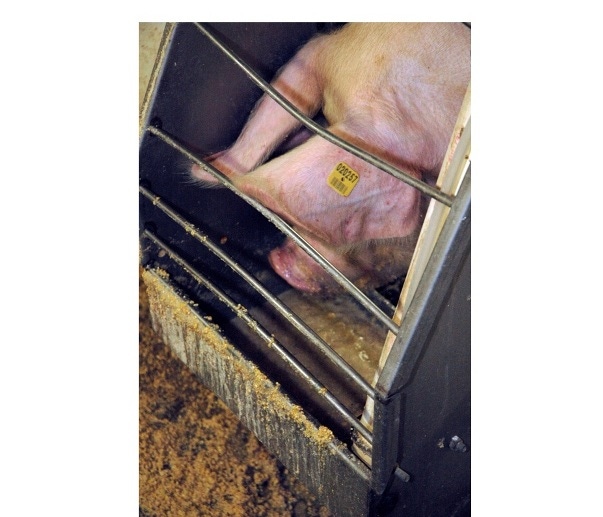May 22, 2013

Heat stress can have a major impact on sow performance and longevity and sows may feel heat stressed at temperatures lower than one might think. As temperatures surpass 70º F, depending upon humidity, sows can start to experience adverse effects from heat stress, such as reduced feed intake. Changes in the ration can help sows continue to consume the nutrients they need to maintain performance and body condition levels.
Sows are most comfortable between 45 and 70º F, with 60 to 65º F being optimal,according to Vern Pearson, swine nutritionist for Purina Animal Nutrition.
“The combination of hot temperatures and humidity results in a high heat stress index and can cause problems for the sow if we don’t account for it,” Pearson says. He explains that heat-stressed sows have a greater potential to experience seasonal infertility, smaller litter sizes, decreased embryo survival rates and death losses. Heat stress can also impact boars, resulting in lower libido, lower sperm counts, abnormal sperm and smaller litters.
Heat stress can be minimized by adjusting the temperature in the facility. Strategies for adequate air movement and cooling include: ventilation systems, air conditioning units, drip cooling, fresh-air inlets, cool cells, nose coolers and water sprinkler systems. No matter the system selected, Pearson advises producers to measure temperatures at the sow’s level and to keep temperatures between 60 and 70 degrees F.
In addition to environmental controls, sow nutrition plays a key role in sow productivity through the summer.
“There’s a direct correlation between heat and reduced feed intake,” Pearson says. “Heat-stressed sows will eat less because digestion gives off body heat and makes the sows even warmer.
Like what you’re reading? Subscribe to the National Hog Farmer Weekly Wrap Up newsletter and get the latest news delivered right to your inbox every Friday!
“Lactating sows will first maintain their litters and then use nutrients from their feed for body condition; sows that are not eating can lose body condition quickly,” he adds. “An under-conditioned sow will be less likely to breed back, so we need to keep the sows eating and in good condition.”
The following are sow nutrition tips from Purina Animal Nutrition to keep sows eating consistently throughout the summer:
1. Promote consistent feed consumption.
“In the summer, the biggest issue is reduced feed consumption in lactation,” Pearson says. “Adjust the ration to avoid those decreases by feeding sows so they maintain a body condition score (BCS) of 3 on a 5-point scale through all stages.”
Summer feed additives, like True Appetizer Feed from Purina Animal Nutrition, can be added to the sow diet to help maintain dry matter intakes.
2. Feed sows according to stage.
BCS is important for all sows, so an ad-libitum ration is suggested during lactation with limit-feeding during gestation.
“Don’t over-feed during gestation; feed to maintain condition,” Pearson says. “Sows that are over-fed in gestation may eat less during lactation. Over-conditioned sows have even more stress during hot weather.”
Lactation feed intake is critical as sows need greater nutrient levels. Pearson recommends adjusting lactation rations in the summer to help sows receive the nutrients needed to maintain condition.
2. Feed nutrient-dense diets.
To compensate for reduced intake potential, feed a palatable, concentrated source of energy to sows. A dense source of energy, fed with a summer sow feed additive, can help the sow consume the nutrients needed to support milk production and maintain body condition.
3. Increase feeding frequency.
Feed breakdown generates heat; therefore, larger meals cause the sow’s body temperature to increase. Feed sows smaller meals throughout the day to decrease the heat generated by the body when breaking down the feed.
Pearson recommends feeding two to three smaller meals throughout the day and to feed sows in the night or in the early morning when it’s cooler to prevent significant body temperature increases.
Switching from two large meals to three small meals has been shown to increase sow feed intake 10 to 15%. Account for this additional feed when formulating summer rations.
4. Provide calories through fat vs. fiber.
Include higher levels of fat, such as choice white grease or vegetable oil, at 2 to 6% of the diet in place of fibrous ingredients, such as soybean hulls, wheat middlings, distiller’s dried grains with solubles (DDGS) and alfalfa.
Pearson says that adding fat at a rate of 50 to 100 pounds per ton of complete feed increases the energy density of the ration, helping the sow to receive necessary nutrients at a lower heat increment than protein.
5. Evaluate trace mineral levels.
“Make sure that vitamins, minerals and amino acids are balanced with the energy you are providing the sows,” Pearson says, explaining that levels may need to be increased during times of heat and humidity.
6. Provide access to quality water.
Pearson advises producers to make sure the sow has access to fresh, quality water at all times. He says that in the summer a lactating sow can consume up to 16 gallons of water per day, with 5 to 10 gallons of water consumed per sow per day on average.
Supplying fresh, clean water at constant rates can help sows meet their water requirements. If using nipple waterers, Pearson recommends adjusting the water flow rate for at least 0.5 gallon of water flow per minute.
7. Keep feed fresh.
Feed is more likely to spoil in warm temperatures. Increase the feeding frequency, feed slightly smaller meals and routinely clean the feeding area to keep feed fresh through the summer.
For more information on summer sow feeding, visit www.trueappetizer.com or contact Vern Pearson at (651) 375-5582 or email: [email protected].
Swine producers, veterinarians and nutritionists can learn more about the Feeding for 30Program and access nutritional resources by visiting www.Feedingfor30.com or www.facebook.com/Feedingfor30.
You might also like:
Temple Grandin Guides Video Tour Behind “Glass Walls” of Pork Processing Plant
You May Also Like



